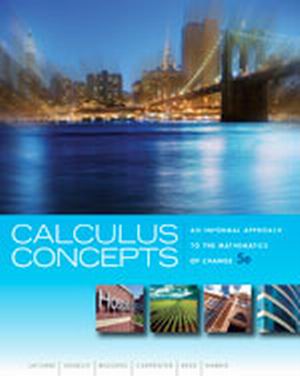Test Bank for Calculus Concepts: An Informal Approach to the Mathematics of Change, 5th Edition, Donald R. LaTorre, John W. Kenelly, Iris B. Reed, Laurel R. Carpenter, Cynthia R. Harris Sherry Biggers
Test Bank for Calculus Concepts: An Informal Approach to the Mathematics of Change, 5th Edition, Donald R. LaTorre, John W. Kenelly, Iris B. Reed, Laurel R. Carpenter, Cynthia R. Harris, Sherry Biggers,
$55.00
Description
Test Bank for Calculus Concepts: An Informal Approach to the Mathematics of Change, 5th Edition, Donald R. LaTorre, John W. Kenelly, Iris B. Reed, Laurel R. Carpenter, Cynthia R. Harris, Sherry Biggers,
You are buying Test Bank. A Test Bank is collection of test questions tailored to the contents of an individual . Test bank may contains the following types of questions: multiple choice, true/false, fill in the blank, matching, essay/short answer, and free-response questions. Please download sample for your confidential.
Each chapter concludes with a summary, a concept check, and review activities
1. INGREDIENTS OF CHANGE: FUNCTIONS AND LIMITS.
Functions–Four Representations. Function Behavior and End Behavior Limits.
Limits and Continuity. Linear Functions and Models. Exponential Functions and Models.
Models in Finance. Constructed Functions. Logarithmic Functions and Models. Quadratic Functions and Models. Logistic Functions and Models. Cubic Functions and Models. Cyclic Functions and Models. Representations of a Sine Function. Characteristics of Sine Functions.
2. DESCRIBING CHANGE: RATES.
Measures of Change over an Interval. Measures of Change at a Point. Rates of Change–Notation and Interpretation. Rates of Change–Numerical Limits and Non-existence. Rates of Change Defined over Intervals. Sketching Rate-of-Change Graphs.
3. DETERMINING CHANGE: DERIVATIVES.
Simple Rate-of-Change Formulas. Exponential, Logarithmic, and Cyclic Rate-of-Change Formulas. Rates of Change for Functions That Can Be Composed. Rates of Change of Composite Functions. Rates of Change for Functions That Can Be Multiplied. Rates of Change for Product Functions. Limits of Quotients and L’Hôpital’s Rule.
4. ANALYZING CHANGE: APPLICATIONS OF DERIVATIVES.
Linearization. Relative Extreme Points. Relative Extreme Points. Inflection Points and Second Derivatives. Marginal Analysis. Optimization of Constructed Functions. Related Rates.
5. ACCUMULATING CHANGE: LIMITS OF SUMS AND THE DEFINITE INTEGRAL.
An Introduction to Results of Change. Limit of Sums and the Definite Integral.
Accumulation Functions. The Fundamental Theorem. Antiderivative Formulas for Exponential, Natural Log, and Sine Functions. The Definite Integral–Algebraically.
Differences of Accumulated Change. Average Value and Average Rate of Change. Integration of Product or Composite Functions.
6. ANALYZING ACCUMULATED CHANGE: INTEGRALS AND ACTION.
Perpetual Accumulation and Improper Integrals. Streams in Business and Biology. Calculus in Economics–Demand and Elasticity. Calculus in Economics–Supply and Equilibrium. Calculus in Probability–Part 1. Calculus in Probability–Part 2. Differential Equations–Slope Fields and Solutions. Differential Equations–Proportionality and Common Forms.
7. INGREDIENTS OF MULTIVARIABLE CHANGE: FUNCTIONS AND RATES.
Multivariable Functions and Contour Graphs. Cross-Sectional Models and Rates of Change. Partial Rates of Change. Compensating for Change.
8. ANALYZING MULTIVARIABLE CHANGE: OPTIMIZATION.
Extreme Points and Saddle Points. Multivariable Optimization. Optimization Under Constraints. Least-Squares Optimization.
Answers to Odd Activities.
Index of Applications.
Subject Index.



Reviews
There are no reviews yet.